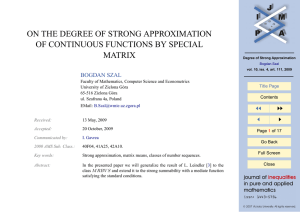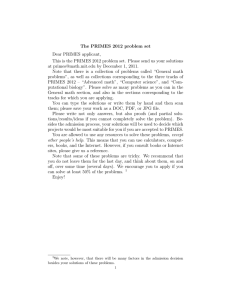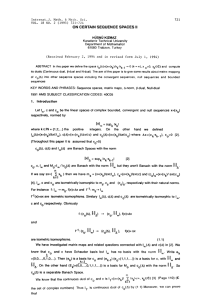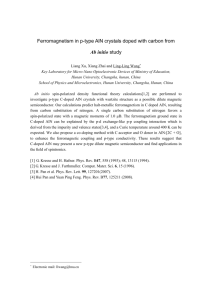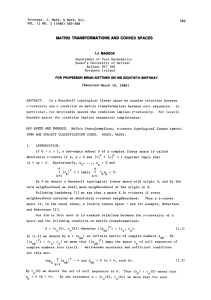ON THE DEGREE OF STRONG APPROXIMATION OF CONTINUOUS I
advertisement
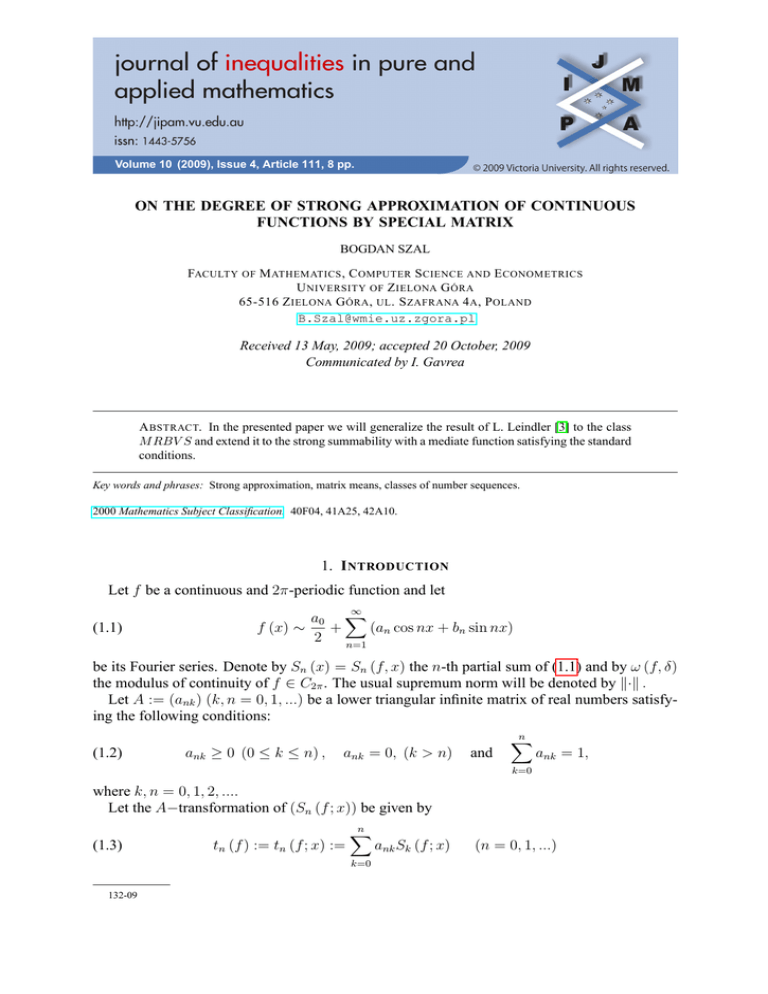
Volume 10 (2009), Issue 4, Article 111, 8 pp.
ON THE DEGREE OF STRONG APPROXIMATION OF CONTINUOUS
FUNCTIONS BY SPECIAL MATRIX
BOGDAN SZAL
FACULTY OF M ATHEMATICS , C OMPUTER S CIENCE AND E CONOMETRICS
U NIVERSITY OF Z IELONA G ÓRA
65-516 Z IELONA G ÓRA , UL . S ZAFRANA 4 A , P OLAND
B.Szal@wmie.uz.zgora.pl
Received 13 May, 2009; accepted 20 October, 2009
Communicated by I. Gavrea
A BSTRACT. In the presented paper we will generalize the result of L. Leindler [3] to the class
M RBV S and extend it to the strong summability with a mediate function satisfying the standard
conditions.
Key words and phrases: Strong approximation, matrix means, classes of number sequences.
2000 Mathematics Subject Classification. 40F04, 41A25, 42A10.
1. I NTRODUCTION
Let f be a continuous and 2π-periodic function and let
∞
(1.1)
f (x) ∼
a0 X
+
(an cos nx + bn sin nx)
2
n=1
be its Fourier series. Denote by Sn (x) = Sn (f, x) the n-th partial sum of (1.1) and by ω (f, δ)
the modulus of continuity of f ∈ C2π . The usual supremum norm will be denoted by k·k .
Let A := (ank ) (k, n = 0, 1, ...) be a lower triangular infinite matrix of real numbers satisfying the following conditions:
(1.2)
ank ≥ 0 (0 ≤ k ≤ n) ,
ank = 0, (k > n)
and
n
X
ank = 1,
k=0
where k, n = 0, 1, 2, ....
Let the A−transformation of (Sn (f ; x)) be given by
(1.3)
tn (f ) := tn (f ; x) :=
n
X
k=0
132-09
ank Sk (f ; x)
(n = 0, 1, ...)
2
B OGDAN S ZAL
and the strong Ar −transformation of (Sn (f ; x)) for r > 0 be given by
( n
) r1
X
Tn (f, r) := Tn (f, r; x) :=
ank |Sk (f ; x) − f (x)|r
(n = 0, 1, ...) .
k=0
Now we define two classes of sequences.
A sequence c := (cn ) of nonnegative numbers tending to zero is called the Rest Bounded
Variation Sequence, or briefly c ∈ RBV S, if it has the property
∞
X
(1.4)
|cn − cn+1 | ≤ K (c) cm
n=m
for m = 0, 1, 2, ..., where K (c) is a constant depending only on c (see [3]).
A null sequence c := (cn ) of positive numbers is called of Mean Rest Bounded Variation, or
briefly c ∈ M RBV S, if it has the property
∞
X
(1.5)
|cn − cn+1 | ≤ K (c)
n=2m
2m
1 X
cn
m + 1 n=m
for m = 0, 1, 2, ... (see [5]).
Therefore we assume that the sequence (K (αn ))∞
n=0 is bounded, that is, there exists a constant K such that
0 ≤ K (αn ) ≤ K
holds for all n, where K (αn ) denotes the sequence of constants appearing in the inequalities
(1.4) or (1.5) for the sequence αn := (ank )∞
k=0 . Now we can give some conditions to be used
later on. We assume that for all n
∞
X
(1.6)
|ank − ank+1 | ≤ Kanm (0 ≤ m ≤ n)
k=m
and
(1.7)
∞
X
|ank − ank+1 | ≤ K
k=2m
2m
1 X
ank
m + 1 k=m
(0 ≤ 2m ≤ n)
hold if αn := (ank )∞
k=0 belongs to RBV S or M RBV S, respectively.
In [1] and [2] P. Chandra obtained some results on the degree of approximation for the means
(1.3) with a mediate function H such that:
Z π
ω (f ; t)
(1.8)
dt = O (H (u))
(u → 0+ ) , H (t) ≥ 0
t2
u
and
Z
t
H (u) du = O (tH (t))
(1.9)
(t → O+ ) .
0
In [3], L. Leindler generalized this result to the class RBV S. Namely, he proved the following theorem:
Theorem 1.1. Let (1.2), (1.6), (1.8) and (1.9) hold. Then for f ∈ C2π
ktn (f ) − f k = O (an0 H (an0 )) .
J. Inequal. Pure and Appl. Math., 10(4) (2009), Art. 111, 8 pp.
http://jipam.vu.edu.au/
O N THE D EGREE OF S TRONG A PPROXIMATION
3
It is clear that
RBV S ⊆ M RBV S.
(1.10)
In [7], we proved that RBV S 6= M RBV S. Namely, we showed that the sequence
if n = 1,
1
dn :=
1+m+(−1)n m if µ ≤ n < µ
m
m+1 ,
(2µm )2 m
where µm = 2m for m = 1, 2, 3, ..., belongs to the class M RBV S but it does not belong to the
class RBV S.
In the present paper we will generalize the mentioned result of L. Leindler [3] to the class
M RBV S and extend it to strong summability with a mediate function H defined by the following conditions:
Z π r
ω (f ; t)
dt = O (H (r; u))
(u → 0+ ) , H (t) ≥ 0 and r > 0,
(1.11)
t2
u
and
Z t
(1.12)
H (r; u) du = O (tH (r; t))
(t → O+ ) .
0
By K1 , K2 , . . . we shall denote either an absolute constant or a constant depending on the
indicated parameters, not necessarily the same in each occurrence.
2. M AIN R ESULTS
Our main results are the following.
Theorem 2.1. Let (1.2), (1.7) and (1.11) hold. Then for f ∈ C2π and r > 0
n
π o r1 .
(2.1)
kTn (f, r)k = O
an0 H r;
n
If, in addition (1.12) holds, then
1
r
(2.2)
kTn (f, r)k = O {an0 H (r; an0 )} .
Using the inequality
ktn (f ) − f k ≤ kTn (f, 1)k ,
we can formulate the following corollary.
Corollary 2.2. Let (1.2), (1.7) and (1.11) hold. Then for f ∈ C2π
π ktn (f ) − f k = O an0 H 1;
.
n
If, in addition (1.12) holds, then
ktn (f ) − f k = O (an0 H (1; an0 )) .
Remark 1. By the embedding relation (1.7) we can observe that Theorem 1.1 follows from
Corollary 2.2.
For special cases, putting
rα−1
if αr < 1,
t
ln πt
if αr = 1,
H (r; t) =
K1
if αr > 1,
J. Inequal. Pure and Appl. Math., 10(4) (2009), Art. 111, 8 pp.
http://jipam.vu.edu.au/
4
B OGDAN S ZAL
where r > 0 and 0 < α ≤ 1, we can derive from Theorem 2.1 the next corollary.
Corollary 2.3. Under the conditions (1.2) and (1.7) we have, for f ∈ C2π and r > 0,
O ({an0 }α )
if αr < 1,
oα n if αr = 1,
O ln aπn0 an0
kTn (f, r)k =
1
O {an0 } r
if αr > 1.
3. L EMMAS
To prove our main result we need the following lemmas.
Lemma 3.1 ([6]). If (1.11) and (1.12) hold, then for r > 0
Z s r
ω (f ; t)
dt = O (sH (r; s))
t
0
(s → 0+ ) .
Lemma 3.2. If (1.2) and (1.7) hold, then for f ∈ C2π and r > 0
(
) r1
n
X
(3.1)
kTn (f, r)k ≤ O
ank Ekr (f ) ,
C
k=0
where En (f ) denotes the best approximation of the function f by trigonometric polynomials of
order at most n.
Proof. It is clear that (3.1) holds for n = 0, 1, ..., 5. Namely, by the well known inequality [8]
kσn,m − f k ≤ 2
(3.2)
n+1
En (f )
m+1
(0 ≤ m ≤ n) ,
where
σn,m (f ; x) =
n
X
1
Sk (f ; x) ,
m + 1 k=n−m
for m = 0, we obtain
r
r
{Tn (f, r; x)} ≤ 12
n
X
ank Ekr (f )
k=0
and (3.1) is obviously valid, for n ≤ 5.
Let n ≥ 6 and let m = mn be such that
2m+1 + 4 ≤ n < 2m+2 + 4.
Hence
r
{Tn (f, r; x)} ≤
3
X
ank |Sk (f ; x) − f (x)|r
k=0
+
k+1
m−1
X 2 X+4
ani |Si (f ; x) − f (x)|r +
k=1 i=2k +2
J. Inequal. Pure and Appl. Math., 10(4) (2009), Art. 111, 8 pp.
n
X
ank |Sk (f ; x) − f (x)|r .
k=2m +5
http://jipam.vu.edu.au/
O N THE D EGREE OF S TRONG A PPROXIMATION
5
Applying the Abel transformation and (3.2) to the first sum we obtain
{Tn (f, r; x)}r
r
≤8
3
X
ank Ekr
(f ) +
k=0
m−1
X
(ani − an,i+1 )
i=2k +2
k=1
+an,2k+1 +4
2k+1
X+3
2k+1
X+4
i
X
|Sl (f ; x) − f (x)|r
l=2k +2
|Si (f ; x) − f (x)|r
i=2k +2
n−1
X
+
k
X
(ank − an,k+1 )
k=2m +2
n
X
|Sl (f ; x) − f (x)|r
l=2m−1
|Sk (f ; x) − f (x)|r
+ ann
k=2m +2
r
≤8
3
X
ank Ekr
(f ) +
k=0
m−1
X
k=1
+an,2k+1 +4
2k+1
X+3
2k+1
X+4
|ani − an,i+1 |
i=2k +2
2k+1
X+3
|Sl (f ; x) − f (x)|r
l=2k +2
|Si (f ; x) − f (x)|r
i=2k +2
n−1
X
+
|ank − an,k+1 |
k=2m +2
2m+2
X+4
+ ann
2m+2
X+3
|Sl (f ; x) − f (x)|r
l=2m +2
|Sk (f ; x) − f (x)|r .
k=2m +2
Using the well-known Leindler’s inequality [4]
(
n
X
1
|Sk (f ; x) − f (x)|s
m + 1 k=n−m
) 1s
≤ K1 En−m (f )
for 0 ≤ m ≤ n, m = O (n) and s > 0, we obtain
r
r
{Tn (f, r; x)} ≤ 8
3
X
ank Ekr (f )
k=0
2k+1
m−1
X
X+3
2k + 3 E2rk +2 (f )
+ K2
|ani − an,i+1 | + an,2k+1 +4
k
k=1
i=2 +2
m
3 (2 +
1) E2rm +2
n−1
X
!)
|ank − an,k+1 | + ann
.
k=2m +2
J. Inequal. Pure and Appl. Math., 10(4) (2009), Art. 111, 8 pp.
http://jipam.vu.edu.au/
6
B OGDAN S ZAL
Using (1.7) we get
{Tn (f, r; x)}r ≤ 8r
3
X
ank Ekr (f )
k=0
m−1
X
1
2k + 3 E2rk +2 (f ) K
+ K2
2k−1 + 2
k +2
2X
ani + an,2k+1 +4
i=2k−1 +1
k=1
3 (2m + 1) E2rm +2 (f ) K
m +2
2X
1
2m−1
+2
!)
ani + ann
.
i=2m−1 +1
In view of (1.7), we also obtain for 1 ≤ k ≤ m − 1,
∞
X
an,2k+1 +4 =
(ani − ani+1 ) ≤
i=2k+1 +4
∞
X
≤
∞
X
|ani − ani+1 |
i=2k+1 +4
|ani − ani+1 | ≤ K
i=2k +2
k +2
2X
1
2k−1 + 2
ani
i=2k−1 +1
and
ann =
∞
X
(ani − ani+1 ) ≤
i=n
|ani − ani+1 |
i=n
∞
X
≤
∞
X
|ani − ani+1 | ≤ K
i=2m +2
m +2
2X
1
2m−1 + 2
ani.
i=2m−1 +1
Hence
r
r
{Tn (f, r; x)} ≤ 8
3
X
ank Ekr (f )
k=0
+ K3
m−1
X
≤ 8r
3
X
E2rk +2 (f )
k=1
ank Ekr (f ) + 2K3
k=0
n
X
≤ K4
k +2
2X
ani + E2rm +2 (f )
ani
i=2m−1 +1
i=2k−1 +1
m +2
2X
m +2
2X
ank Ekr (f )
k=3
ank Ekr (f ) .
k=0
This ends our proof.
4. P ROOF OF T HEOREM 2.1
Using Lemma 3.2 we have
( n
) r1
( n
X
X
r
r
(4.1)
|Tn (f, r; x)| ≤ K1
ank Ek (f )
≤ K2
ank ω f ;
k=0
J. Inequal. Pure and Appl. Math., 10(4) (2009), Art. 111, 8 pp.
k=0
π
k+1
) r1
.
http://jipam.vu.edu.au/
O N THE D EGREE OF S TRONG A PPROXIMATION
7
If (1.7) holds, then, for any m = 1, 2, ..., n,
anm − an0
m−1
X
≤ |anm − an0 | = |an0 − anm | = (ank − ank+1 )
k=0
≤
m−1
X
|ank − ank+1 | ≤
k=0
∞
X
|ank − ank+1 | ≤ Kan0 ,
k=0
whence
anm ≤ (K + 1) an0 .
(4.2)
Therefore, by (1.2),
(K + 1) (n + 1) an0 ≥
(4.3)
n
X
ank = 1.
k=0
First we prove (2.1). Using (4.2), we get
n
n
X
X
π
π
r
r
ank ω f ;
≤ (K + 1) an0
ω f;
k
+
1
k+1
k=0
k=0
Z n+1 π
r
dt
≤ K3 an0
ω f;
t
1
Z π r
ω (f ; u)
= πK3 an0
du
π
u2
n+1
and by (4.1), (1.11) we obtain that (2.1) holds.
Now, we prove (2.2). From (4.3) we obtain
n
X
ank ω
r
k=0
π
f;
k+1
h
1
(K+1)an0
≤
X
i
−1
ank ω
r
k=0
π
f;
k+1
n
X
+
k=
h
ank ω
1
(K+1)an0
i
−1
r
π
f;
k+1
.
Again using (1.2), (4.2) and the monotonicity of the modulus of continuity, we get
h
n
X
k=0
ank ω
r
π
f;
k+1
≤ (K + 1) an0
1
(K+1)an0
i
−1
X
ω
r
k=0
π
f;
k+1
n
X
+ K4 ω r (f ; π (K + 1) ano )
k=
Z
(4.4)
1
(K+1)an0
≤ K5 an0
1Z
≤ K6 an0
π
an0
J. Inequal. Pure and Appl. Math., 10(4) (2009), Art. 111, 8 pp.
h
1
(K+1)an0
ank
i
−1
π
ω f;
dt + K4 ω r (f ; π (K + 1) ano )
t
r
ω (f ; u)
r
du + ω (f ; an0 ) .
u2
r
http://jipam.vu.edu.au/
8
B OGDAN S ZAL
Moreover
a n0
ω r (f ; an0 ) ≤ 4r ω r f ;
Z an02 r
ω (f ; t)
≤ 2 · 4r
dt
an0
t
Z a2 n0 r
ω (f ; t)
≤ 2 · 4r
dt.
t
0
Thus collecting our partial results (4.1), (4.4), (4.5) and using (1.11) and Lemma 3.1 we can see
that (2.2) holds. This completes our proof.
(4.5)
R EFERENCES
[1] P. CHANDRA, On the degree of approximation of a class of functions by means of Fourier series,
Acta Math. Hungar., 52 (1988), 199–205.
[2] P. CHANDRA, A note on the degree of approximation of continuous function, Acta Math. Hungar.,
62 (1993), 21–23.
[3] L. LEINDLER, On the degree of approximation of continuous functions, Acta Math. Hungar., 104
(1-2), (2004), 105–113.
[4] L. LEINDLER, Strong Approximation by Fourier Series, Akadèmiai Kiadò, Budapest (1985).
[5] L. LEINDLER, Integrability conditions pertaining to Orlicz space, J. Inequal. Pure and Appl. Math.,
8(2) (2007), Art. 38.
[6] B. SZAL, On the rate of strong summability by matrix means in the generalized Hölder metric, J.
Inequal. Pure and Appl. Math., 9(1) (2008), Art. 28.
[7] B. SZAL, A note on the uniform convergence and boundedness a generalized class of sine series,
Comment. Math., 48(1) (2008), 85–94.
[8] Ch. J. DE LA VALLÉE - POUSSIN, Leçons sur L’Approximation des Fonctions d’une Variable
Réelle, Paris (1919).
J. Inequal. Pure and Appl. Math., 10(4) (2009), Art. 111, 8 pp.
http://jipam.vu.edu.au/
